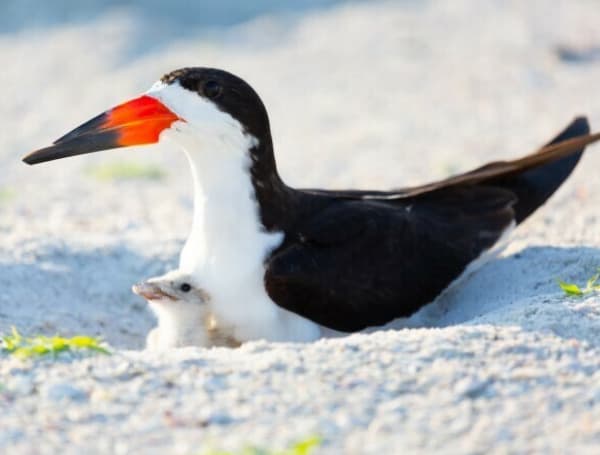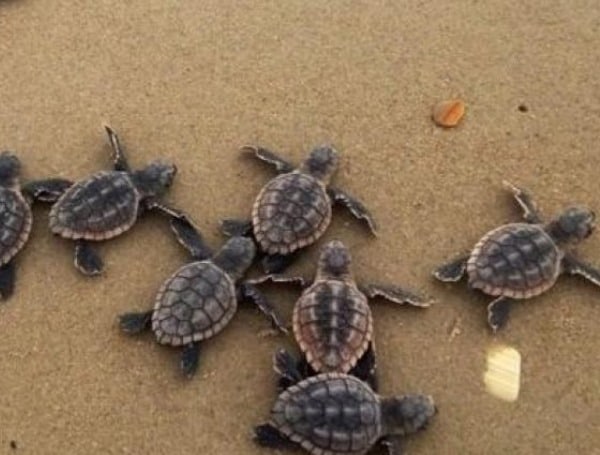The Florida Fish and Wildlife Conservation Commission (FWC) reminds the public that as we enjoy our beaches this weekend and beyond, everyone can do their part to help sea turtles and shorebirds have a successful nesting season by giving them space, removing beach furniture and trash before leaving for the day, keeping beaches clean and dark, and never disturbing their nests.
Because our state’s shorelines are critical for sea turtle and shorebird nesting, all beachgoers can have a big impact on their nesting success.
Florida’s sandy beaches provide important spring and summer nesting habitat for several species of federally threatened and endangered sea turtles, including loggerhead, leatherback, and green sea turtles, with occasional nesting by federally endangered Kemp’s ridley sea turtles.
Our beaches are also critical habitats for imperiled beach-nesting birds, including black skimmers, least terns, snowy plovers, and American oystercatchers.
In the news: Analyzing Sea Turtle Sickness, UF Researchers Discover They Can Pull Human DNA From Thin Air
Getting too close (50 feet or less) to nesting sea turtles can cause them to leave the beach before they complete nesting. All species of sea turtles and their nests are protected and should not be disturbed — it is illegal to harm, harass or take nesting sea turtles, their eggs, and hatchlings.
It is also best to keep at least 300 feet from nesting shorebirds, seabirds, and wading birds to prevent them from flushing from their breeding sites, leaving vulnerable eggs and chicks exposed to the elements and predators. Shorebirds and seabirds also nest in shallow scrapes in the sand, and their eggs and chicks are well-camouflaged, making them vulnerable to being stepped on.
In addition to giving space to sea turtles and shorebirds, beachgoers can help with nesting success for our vulnerable sea turtles and shorebirds every time they visit the shore:
- Clear the way at the end of the day! Properly dispose of all trash, fill in human-made holes in the sand, and remove all beach toys and furniture from the beach before sunset. Obstacles on the beach can prevent sea turtles from nesting. Trash and other obstacles can also prevent sea turtle hatchlings from reaching the water once they emerge from their nests, as well as entangle shorebirds, turtles and other wildlife. Food scraps attract predators, such as raccoons and crows, that can prey on sea turtle hatchlings, as well as shorebird eggs and chicks.
- Do the flock walk! Steer clear of flocks of birds on the beach and keep an eye out for shorebird eggs and chicks to avoid stepping on them. Never enter posted areas. Be on the lookout for signs designating Critical Wildlife Areas on the beach or coastal islands as these areas are closed to public access to protect wading birds and shorebirds while they nest and raise their chicks.
- Lights out! Turn off lights or close curtains after dark to ensure nesting turtles are not disturbed or disoriented as they come ashore and hatchlings will not become disoriented when they emerge from their nests. Make sure exterior lighting adjacent to nesting beaches is long, low and shielded. Avoid using flashlights or cell phone lights and taking flash photos after dark on the beach.
- Leave fireworks to the professionals. Keep personal fireworks off the beach and at home; attend an official event instead. The loud sounds and bright lights of personal fireworks on Florida’s beaches and waterways can have catastrophic effects on nesting birds and their chicks, as well as nesting sea turtles.
- Pet owners can also help by keeping dogs at home or on a short leash and far away from wildlife when bringing dogs to pet-friendly beaches. Even friendly dogs can be seen as predators by shorebirds, which can cause them to flush and leave their eggs and chicks.
Android Users, Click To Download The Free Press App And Never Miss A Story. Follow Us On Facebook and Twitter. Signup for our free newsletter.
We can’t do this without your help; visit our GiveSendGo page and donate any dollar amount; every penny helps.


